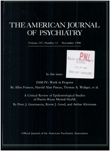Cerebral blood flow changes during sodium-lactate-induced panic attacks
Abstract
Dynamic single-photon emission computed axial tomography (CAT) with inhaled xenon-133 was used to measure regional cerebral blood flow in 10 drug-free patients with DSM-III-diagnosed panic disorder and in five normal control subjects. All subjects underwent regional cerebral blood flow studies while at rest or during normal saline infusion and during sodium lactate infusion. Six of the 10 patients and none of the control subjects experienced lactate-induced panic attacks. Lactate infusion markedly raised hemispheric blood flow levels in both control subjects and patients who did not panic. Patients who did panic experienced either a minimal increase or a decrease in hemispheric blood flow.
Access content
To read the fulltext, please use one of the options below to sign in or purchase access.- Personal login
- Institutional Login
- Sign in via OpenAthens
- Register for access
-
Please login/register if you wish to pair your device and check access availability.
Not a subscriber?
PsychiatryOnline subscription options offer access to the DSM-5 library, books, journals, CME, and patient resources. This all-in-one virtual library provides psychiatrists and mental health professionals with key resources for diagnosis, treatment, research, and professional development.
Need more help? PsychiatryOnline Customer Service may be reached by emailing [email protected] or by calling 800-368-5777 (in the U.S.) or 703-907-7322 (outside the U.S.).



